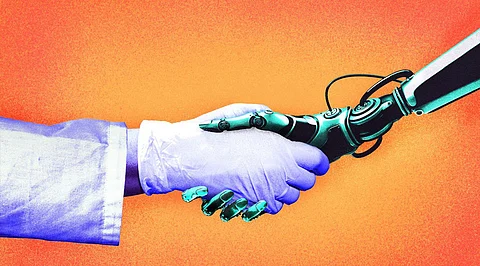

Different forms of robotics are used in the healthcare sector to boost the existing quality of treatment while also assisting people in doing tasks they would not have been able to do in the past, or doing things faster and with less mistakes. In medicine, healthcare robots assist by alleviating medical professionals from basic activities that divert their attention away from more significant responsibilities, as well as by making medical procedures secure and less expensive for patients. They can also conduct precise surgery in small spaces and transfer hazardous materials.
As the coronavirus outbreak grew into a full-fledged pandemic in early 2020, causing numerous businesses to close, robot manufacturers found themselves in an unprecedented situation, with many seeing an increase in orders. Robots do not need masks, are easily disinfected, and, obviously, do not become ill.
Since then, an army of robots have been distributed around the world to assist with the issue. Patients are being monitored, clinics are being sanitized, supplies are being made, and emergency medical staffs are being aimed to prevent their virus exposure. Not all robots are self-contained; in reality, many need direct human management and are restricted to basic, routine tasks.
As per the report of Tech Xplore, in a piece in Nature Machine Intelligence, Johns Hopkins researchers discuss how the coronavirus pandemic has driven unexpected innovations in automation, while at the same time revealing bottlenecks to deploying robotic systems in health care settings. They contend that advances in human-robot interaction—such as improving robots' capabilities to feel, touch, and decide—will determine if the robots of tomorrow will help hospitals stay ahead of the next pandemic.
They also mentioned that, in the commentary, the team identifies three ways robots have greatly enhanced patient care and provider safety during COVID-19: minimizing contact between infected patients and care providers, reducing the need for PPE, and giving providers more time to focus on critical tasks. They look ahead to how technologies can be leveraged to develop adaptable and reliable robots for future infectious disease crises.
According to The Conversation, hopefully, COVID-19 will accelerate the adoption of existing robots and their adaptation to new niches, but it might also lead to new robots. Laboratory and supply chain automation is emerging as an overlooked opportunity. Automating the slow COVID-19 test processing that relies on a small set of labs and specially trained workers would eliminate some of the delays currently being experienced in many parts of the U.S.
Automation is not particularly exciting, but just like the unglamorous disinfecting robots in use now, it is a valuable application. If government and industry have finally learned the lessons from previous disasters, more mundane robots will be ready to work side-by-side with the health care workers on the front lines when the next pandemic arrives.
Join our WhatsApp Channel to get the latest news, exclusives and videos on WhatsApp
_____________
Disclaimer: Analytics Insight does not provide financial advice or guidance. Also note that the cryptocurrencies mentioned/listed on the website could potentially be scams, i.e. designed to induce you to invest financial resources that may be lost forever and not be recoverable once investments are made. You are responsible for conducting your own research (DYOR) before making any investments. Read more here.
